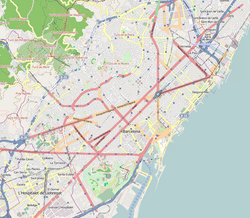Teatro del Liceu
| Teatro del Liceo de Montesión (1837–1847) | |

Liceu façade (2006)
|
|
| Address |
La Rambla, 51–59 Ciutat Vella, Barcelona Spain |
|---|---|
| Owner | public theatre |
| Type | Opera House |
| Capacity | 2,292 seats on 6 levels |
| Production | Fundació del Gran Teatre del Liceu |
| Construction | |
| Opened | 1847 (founded 1837 in another place) |
| Rebuilt | 1862, 1999 (after fires in 1861 and 1994) |
| Years active | active |
| Architect | Miquel Garriga i Roca (1847), Josep Oriol Mestres (1862), Ignasi de Solà-Morales (1999) |
| Website | |
| www.liceubarcelona.cat | |
The Gran Teatre del Liceu (Catalan pronunciation: [ˈɡɾan teˈatɾə ðəɫ ɫiˈsɛw]), or simply Liceu in Catalan and Liceo in Spanish, is an opera house on La Rambla in Barcelona, Catalonia, Spain. The Liceu opened on 4 April 1847.
In 1837, the Liceo Filodramático de Montesión (Philodramatic Lyceum of Montesión, now named Conservatori Superior de Música del Liceu) was founded in Barcelona to promote musical education (hence the name "Liceo", or lyceum) and organize scenic representations of opera performed by Liceo students. A theater was built in the convent building — named Teatro de Montesión or Teatro del Liceo de Montesión — and plays and operas performed: the first was Vicenzo Bellini's Norma (3 February 1838). The repertoire was Italian, the most performed composers being Donizetti and Mercadante as well as Bellini and Rossini. The Barcelona premiere of Hérold's Zampa was held here.
In 1838 the society changed its name to Liceo Dramático Filarmónico de S. M. la Reina Isabel II (Dramatic Philharmonic Lyceum of H.M. Queen Elisabeth). Lack of space, as well as pressures brought to bear by a group of nuns (who were the former proprietors of the convent and had recovered rights to return), motivated the Liceu to leave its headquarters in 1844. The last theatre performance was on 8 September.
The Trinitarian convent building located in the centre of the town at la Rambla was purchased. The managers of the Liceu entrusted Joaquim de Gispert d'Anglí with a project to make the construction of the new building viable. Two different societies were created: a "building society" and an "auxiliary building society". Shareholders of the building society obtained the right of use in perpetuity of some theatre boxes and seats in exchange for their economic contributions. Those of the second society contributed the rest of the money necessary in exchange for property of other spaces in the building including some shops and a private club called the Círculo del Liceo.
...
Wikipedia

